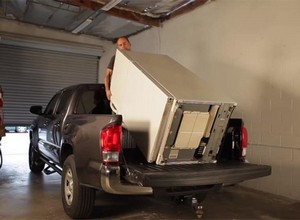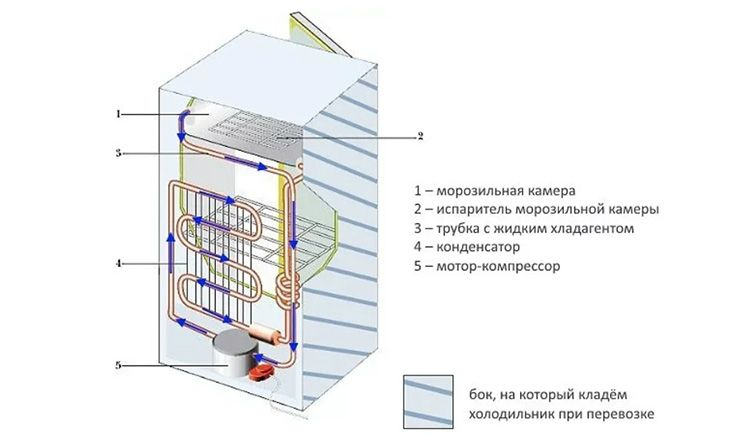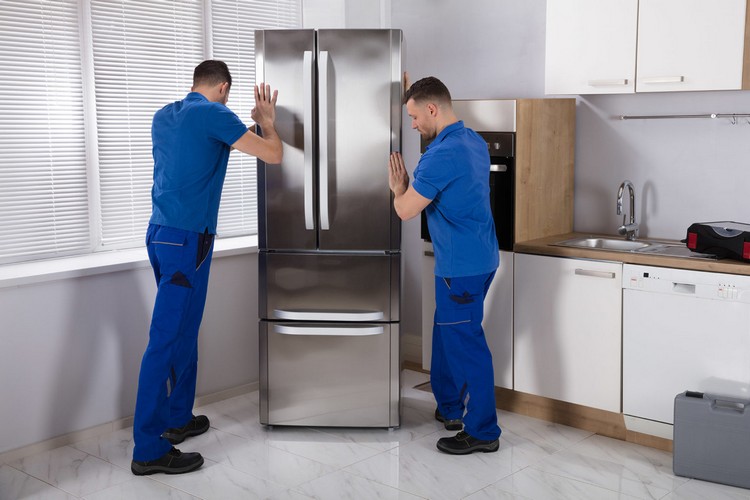Is it possible to transport the fridge lying flat: peculiarities of horizontal transportation
 When moving or buying a new refrigerator, it is transported. And according to the recommendations of the manufacturer of such appliances, it is possible to transport the appliances only if they are placed vertically. That is in its "working" position.
When moving or buying a new refrigerator, it is transported. And according to the recommendations of the manufacturer of such appliances, it is possible to transport the appliances only if they are placed vertically. That is in its "working" position.
Why is it necessary? To prevent damage to its components, namely the capillary tubes through which the freon circulates, as well as the compressor.
But what to do if you do not have a specialized car with a high board or a cargo body, where you can place the refrigerator "standing"? What experts advise on this matter and what you need to know about the transportation of such equipment?
Contents [Show]
Is it acceptable to transport your fridge horizontally
There is not always a section in the operation manuals of such appliances, where the rules of transportation are explained. And if there is, it is clearly stated there that transportation, delivery is possible only when the refrigerator is placed vertically. That is exactly the way it is originally placed in the package from the manufacturer (sometimes wooden crate is used instead of it, as well as wrapping from the film).
What is the reason for that? Because during the transportation on the machine there is vibration, as well as dynamic load on all parts of the equipment. And the capillary system is designed to work in an upright position. So in this case the risk of damage is minimal.
Also, the compressor itself is placed in such a way that it is not resistant to lateral loading. This can even lead to the fact that it will simply tear off, and along with it damage the coil tubes. Subsequent repair in many cases is impractical. In other words, it would be cheaper to buy a new refrigerator.
Specialists of service centers, in turn, assert that transportation of large-sized equipment in a horizontal position is possible.
But if the following rules are observed:
- The angle of inclination should not exceed 40 degrees. That is the refrigerator will be placed not strictly horizontally but under a slope.
- The compressor must be rigidly fixed beforehand.
- The entire capillary system must be placed upwards (regardless of which side it is placed by the manufacturer).
In this case, the risk of any problems is minimal.
When the fridge is to be transported horizontally
Primarily, this variant of transportation is used if there is no truck designed for transportation of large-sized equipment (with high sides). In this case, the refrigerator is placed horizontally. But everything should be done to minimize the probability of its breakage.
Also, please note that there are several refrigerator variants that cannot be transported "lying down".
What refrigerators can not be transported horizontally
Such a ban is stipulated for all old "Soviet" refrigerators, as well as for the most modern ones equipped with the No Frost system. They can only be placed vertically.
And that's because of the weight of their compressors and electric motor. It is so big that even the slightest vibration can tear them off and damage the capillary system.
And old refrigeration equipment often uses large volumes of Freon. It is flammable. That is, accidental damage to the capillary sealed system can even provoke a massive fire.
Preparing your refrigerator for transport
Both new and used refrigerators must be properly prepared for transportation, because they are not designed for horizontal transport.
General recommendations:
- Completely empty both the freezer and refrigerator compartments of food, shelves. Anything that can be removed should be removed. Additionally, the plastic decorative panel and handle may be removed (the former is fixed on plastic latches, the handle can be unscrewed).
- Perform defrosting of the refrigerator. That is to disconnect from a power supply, to allow it to stand for at least 12 hours.
- Carefully wash the internal chambers with a soft sponge and soap solution.
- If manual defrosting is foreseen, drain off all water, dry all "insides" of the fridge thoroughly.
- Fix the compressor. For this purpose, most manufacturers provide installation of transport bolts (2 - 3 pieces). Also it is additionally fixed with the help of elastic straps, which additionally contribute to vibration damping.
- If necessary, the door of the refrigerating and freezing chamber is dismantled (for example, if the refrigerator cannot be removed from the room otherwise, because its dimensions exceed the door opening).
- If the doors are not dismantled, they are fixed with a strap, masking tape or film.
Then you can proceed directly to the loading. The main thing is to avoid sudden movements, jolts.
If the handle has not been previously dismantled, you can not take hold of it as a grip. It is not designed for high dynamic loads and will simply come off.
In no case the refrigerator must not be turned "upside down" during loading. In 99% of cases, it will end up in the capillary system of the tubes, it will require a complete cleaning (and this can only be done in the service center).
The dismantled door should be reinstalled at the time of transportation (for additional protection of the enamel or acrylic coating on the inside).
On which side is the refrigerator to be transported horizontally
The capillary system must be placed on top when transporting in the lying position. With most refrigerators, it is located just behind (or in front of) the rear wall.
Accordingly, it is necessary to lay the technique on the "door". In this case the probability of tube damage is minimal.
It is also possible to find out which side the tubes are located on, from the manual.
But it should be noted that in some models, they are located on both sides. That is, on one of them freon goes to the compressor, on the other side it goes to the capillary system. And the "coming out" tube should be located on top.
How do you know that? Just touch it gently with your hand. But this should be done only after turning off the refrigerator, giving it at least 15 - 20 minutes to stand still. The tube that will be warm is the one you are looking for. It should be placed strictly at the top.
When you can use your refrigerator after transportation.
The instructions state that the refrigerator should not be turned on immediately after transportation. You have to wait. How long? At least 2 to 4 hours if transported in a warm season (at an ambient temperature of about 20 degrees or higher). And not less than 6 - 8 hours if in a cold season (when the temperature is less than 20 degrees).
A specialist recommends not using the equipment after transportation for 24 hours, and it must be placed vertically all that time.
What is it for? Inside the compressor is viscous oil. And it has to be located at the bottom, where all the rotating parts are.
And after transporting the refrigerator on its side for a long time, it accumulates on the side. This can cause the oil to get into the capillary system when the refrigerator is turned on. Naturally, this will cause it to clog, and then it will be necessary to replace it, because the refrigerator simply will not work (freon "can not" circulate).
What effect does ambient temperature have? Oil viscosity depends on it directly. The warmer the temperature, the lower the viscosity, that is the oil will flow to the bottom of the compressor faster. The lower the temperature, the more viscous it is and the longer it will take.
Why it is important to transport your refrigerator with care
Both the capillary system and the compressor in the refrigerator do not have any gaskets or rubbers to absorb vibrations.
And the motor itself is located on the frame, immersed in oil. All this is necessary so that during the work it did not create any additional noise and the vibration was minimal. That is in fact it is not fixed in any way. And from the slightest movement it can move from its frame, damage the tubes (they are quite thin, which is necessary to provide the heat exchange).
Ignoring the rules of transportation will certainly lead to their damage.
And despite the huge number and variety of models of refrigerators, they all work according to the same scheme. And their structure is identical. The only differences are the power of the installed compressor, the capacity of the circulation system, and the control board.
Other refrigerator transport options
In addition to the horizontal placement of the refrigerator, it can be transported:
- vertically - the most preferred option;
- Tilted.
But in any of these cases it can be plugged in only after 2 - 8 hours.
Only after the oil has completely sunk to the bottom of the compressor. A wooden or plastic crate can be used for additional protection.
Vertical Transportation
In this case, the compressor, the doors are also necessarily fixed rigidly. All shelves, drawers - removed (it is recommended to carry them separately).
From the outside, the refrigerator is either wrapped in film or it is simply placed in the factory packing (together with the foam).
At a slant.
In this case, it is necessary to follow the same rules that are used for horizontal transportation.
But the refrigerator itself is placed at an inclination. The optimal angle is 40 degrees or more. The equipment is rigidly fixed by means of transport straps.
To sum up, transporting the refrigerator is a non-trivial task and it is necessary to approach it with special care. And if there is a possibility to refuse the horizontal transportation, it is better to use it. Use it only as a last resort and only for short distances (up to 100 km).
Old refrigerators or those equipped with the NoFrost system must be transported only vertically (unless otherwise specified by the manufacturer).
Useful Video
Here is a video that explains if your refrigerator can be transported lying down:








